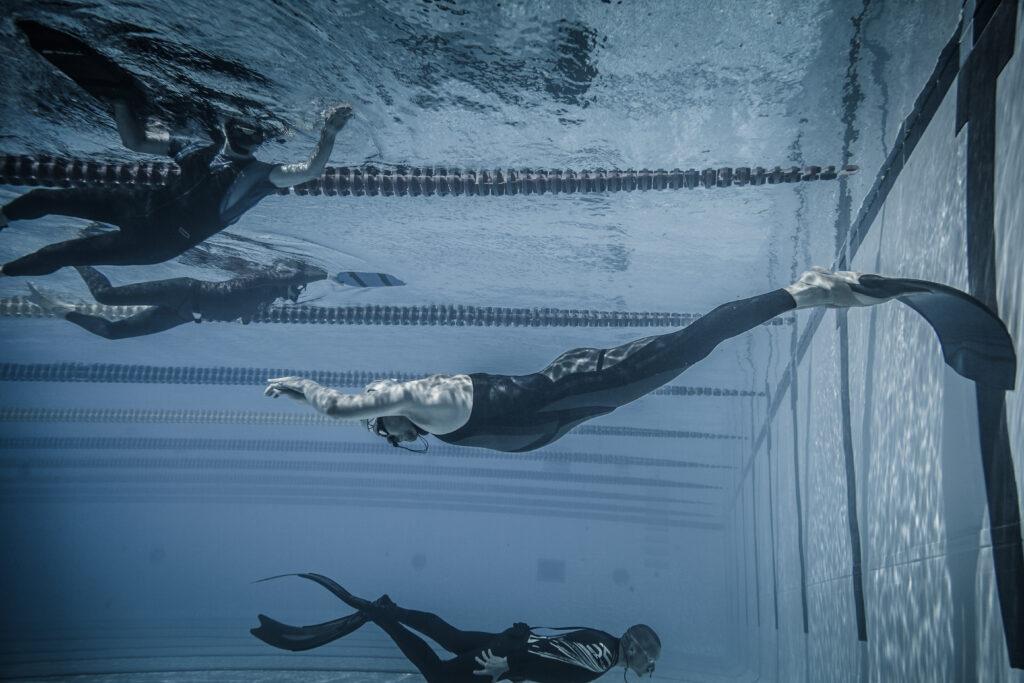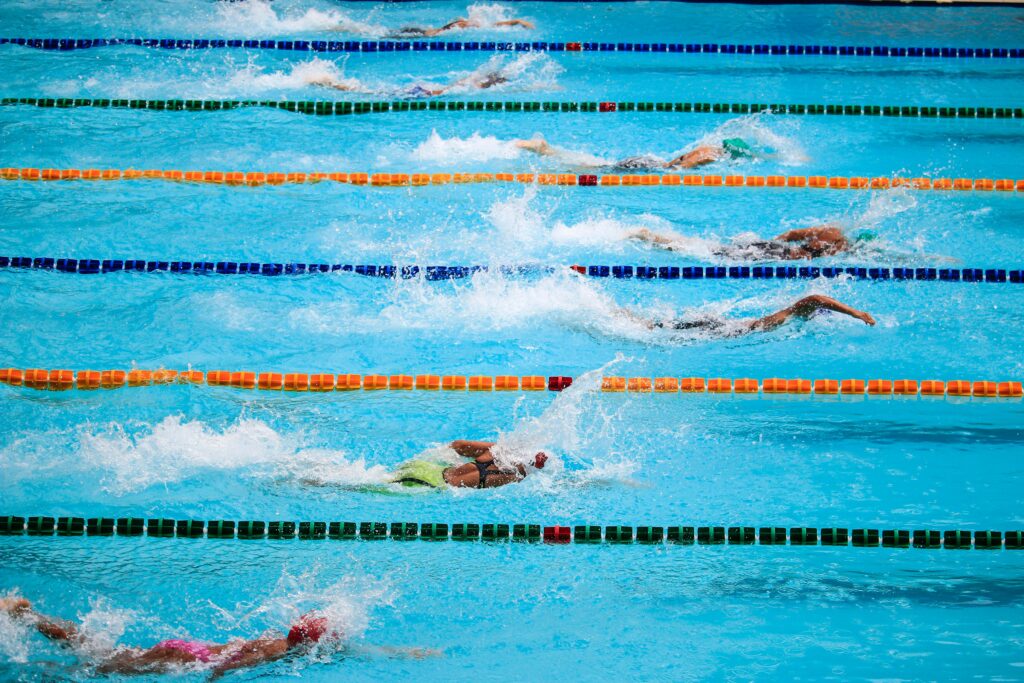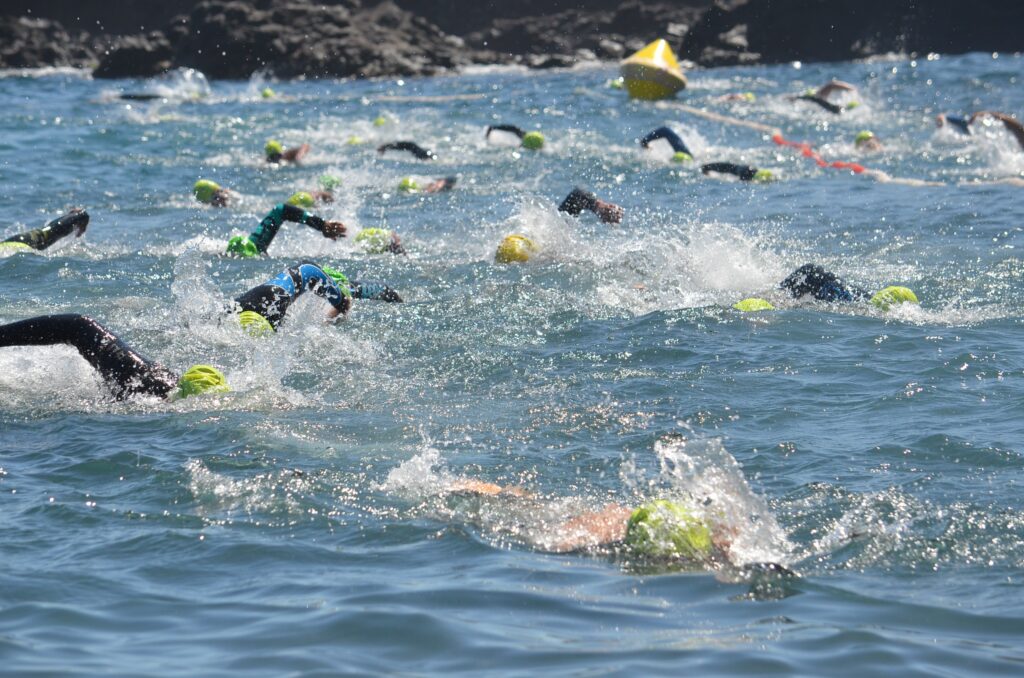When it comes to butterfly stroke, the leg kick is an essential component that propels swimmers through the water. The dolphin kick, a kicking technique that mimics the movement of a dolphin’s tail, is commonly used in the butterfly stroke. However, some swimmers have turned to dolphin fin style fins to improve their leg kick and overall performance in the water.
Dolphin fin style fins are designed to replicate the movement of a dolphin’s tail and provide more propulsion than traditional swim fins. The fins are longer and narrower than traditional fins, forcing swimmers to use a more fluid and powerful kick. Many swimmers believe that using dolphin fin style fins can help improve their leg kick technique and overall speed in the water.
Key Takeaways
- Dolphin fin style fins are designed to replicate the movement of a dolphin’s tail and provide more propulsion than traditional swim fins.
- Using dolphin fin style fins can help improve leg kick technique and overall speed in the water.
- While dolphin fin style fins can be beneficial, they may also present challenges and require proper training to use effectively.
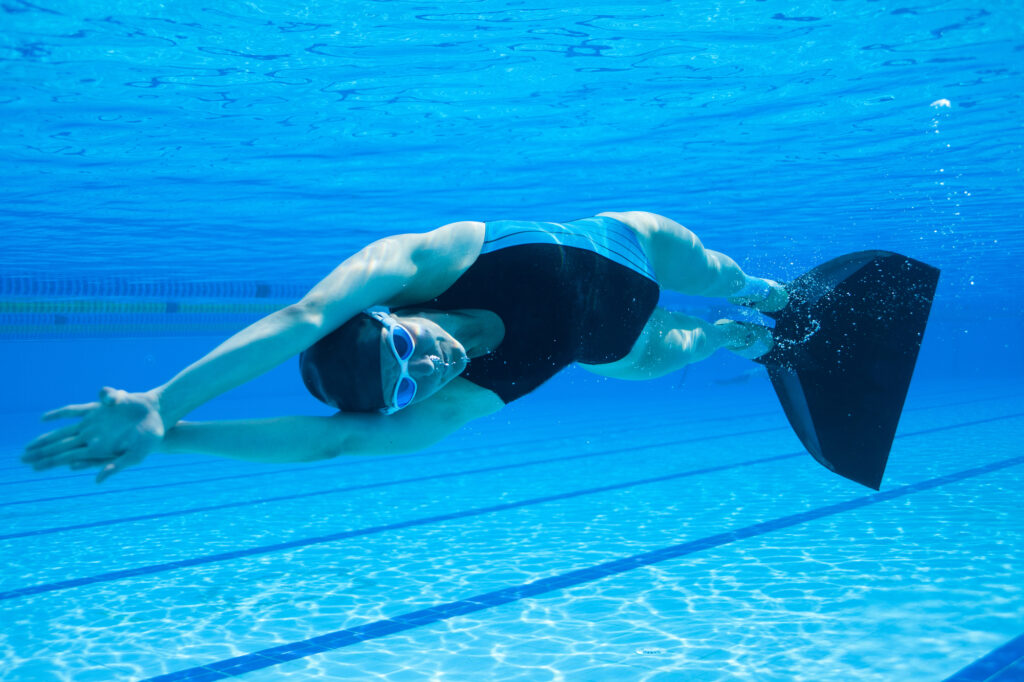
Understanding Dolphin Fin Style
When we talk about dolphin fin style, we refer to the technique used in the butterfly stroke where the swimmer kicks their legs in a similar motion to a dolphin’s tail. This technique is characterised by a simultaneous up-and-down movement of the legs, with the feet remaining close together and the knees bending slightly.
The dolphin fin style is known for its effectiveness in generating propulsion in the water, making it a popular choice for competitive swimmers. The technique allows for a powerful and efficient kick, which can help to improve overall speed and performance in the water.
One way to improve the dolphin fin style kick is by using a monofin, which is a type of fin that connects both feet together. The monofin helps to increase the surface area of the feet, allowing for a more powerful kick and greater propulsion through the water.
It’s important to note that while the dolphin fin style can be an effective technique for swimming the butterfly stroke, it may not be suitable for all swimmers. Some swimmers may find it difficult to master the technique, while others may prefer to use alternative kicking techniques.
In summary, the dolphin fin style is a popular technique used in the butterfly stroke that can help to improve overall speed and performance in the water. Using a monofin can be an effective way to improve the technique, but it’s important to remember that the technique may not be suitable for all swimmers.
Butterfly Stroke Basics
The butterfly stroke is a challenging and technical swimming stroke that requires a lot of strength and coordination. It is characterised by the undulating body movement and the dolphin kick, which is performed by the legs.
To perform the butterfly stroke, we start by lying face down in the water with our arms extended forward. We then simultaneously pull our arms backwards, bending our elbows and lifting our chest out of the water. This is followed by the dolphin kick, where our legs move in a similar motion to a dolphin’s tail, propelling us forward.
It is important to note that the dolphin kick consists of two phases: the downbeat and the upbeat. During the downbeat, our legs move downward and provide propulsion, while during the upbeat, our legs move up in preparation for the next downbeat. We perform two dolphin kicks per butterfly stroke cycle.
To perform the dolphin kick effectively, we need to keep our legs together and our toes pointed. We also need to ensure that we are kicking from the hips, which undulate as we move. Our ankles should be relaxed, and our legs should move upwards during the undulating body movement, as our head and shoulders dive downwards.
Overall, the butterfly stroke is an advanced swimming technique that requires a lot of practice and patience to master. However, with proper technique and training, we can improve our performance and efficiency in the water.
Leg Kick Mechanics in Swimming
When it comes to swimming, the leg kick is an essential part of the butterfly stroke. It provides the necessary propulsion to move forward in the water. Dolphin fins are often used by swimmers to improve their leg kick and overall performance. In this section, we will discuss the mechanics of the leg kick in swimming and how dolphin fins can improve it.
The leg kick in swimming involves the coordinated movement of the hips, knees, and ankles. The legs move up and down in a wave-like motion, propelling the swimmer forward. The kick is initiated by the hips, which drive the legs down towards the bottom of the pool. The knees then bend, and the ankles flex, creating a powerful downward thrust. The legs then return to their original position, ready for the next kick.
Dolphin fins can improve the leg kick in several ways. First, they increase the surface area of the feet, which allows for a more powerful kick. Second, they provide additional resistance, which strengthens the muscles used in the kick. Third, they help to improve technique by forcing the swimmer to maintain a consistent kick rhythm.
It is important to note that while dolphin fins can be beneficial, they are not a magic solution to improving the leg kick. Proper technique, strength training, and regular practice are all essential components of developing a strong and efficient leg kick.
In summary, the leg kick is a crucial aspect of the butterfly stroke in swimming. Dolphin fins can be a useful tool in improving the leg kick by increasing surface area, providing resistance, and improving technique. However, they are not a substitute for proper training and practice.
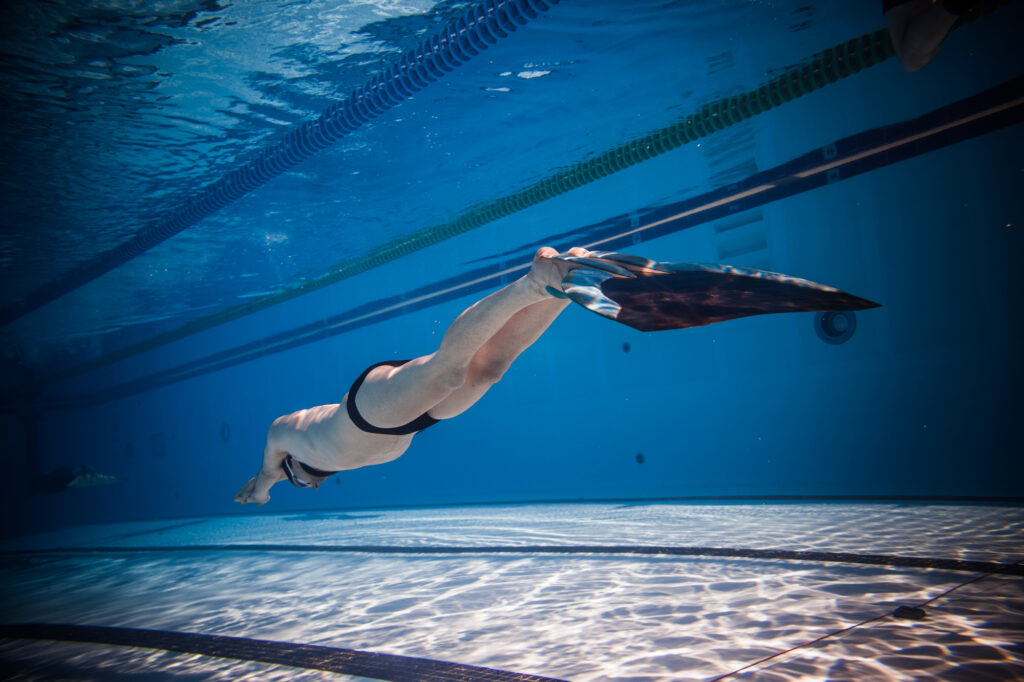
Influence of Dolphin Fin Style on Leg Kick
When it comes to swimming the butterfly stroke, the leg kick is just as important as the arm stroke. The dolphin kick is a popular technique used in the butterfly stroke, and it involves the legs moving in sync and performing movements similar to a dolphin’s tail. This kick is also known as the dolphin fin style kick.
Research shows that using the dolphin fin style kick when swimming the butterfly stroke can improve the leg kick. According to a study by Melton Swimming, once the swimmer has mastered a good streamlined dolphin kick, other aspects of the stroke can be introduced, such as sculling with arms extended in front of shoulders in coordination with a down kick. This introduces the first kick in the butterfly stroke, which is coordinated with the outward scull.
Another study by PubMed Central found that using the breaststroke kick and flutter kick when swimming with diving gear seems to be comparable to the dolphin kick in terms of average velocity and parameters reflecting the economy of propulsion. However, the study also suggests that a search for fin swimming techniques with the aim of achieving specific goals seems reasonable.
In a three-dimensional analysis of hip and knee joint movements during dolphin kicking and butterfly swimming by ResearchGate, eight male swimmers performed three trials using dolphin kick with a kickboard, underwater dolphin kick, and butterfly swimming at 80% maximal effort in a water flume. The study found that the butterfly swimming technique resulted in a greater range of motion in the hip and knee joints compared to the dolphin kick with a kickboard and underwater dolphin kick.
Overall, using the dolphin fin style kick when swimming the butterfly stroke can improve the leg kick. However, it is important to note that there are other techniques that can be used as well, and the choice of technique may depend on specific goals.
Comparative Analysis: Traditional Vs Dolphin Fin Style
When it comes to swimming butterfly stroke, the type of fins you use can make a significant difference in your performance. In this section, we will compare traditional swim fins with the dolphin fin style and discuss their respective advantages and disadvantages.
Traditional Swim Fins
Traditional swim fins are the most commonly used type of fins for swimming butterfly stroke. They are designed to mimic the shape and movement of a fish’s tail, providing swimmers with extra propulsion and speed. Traditional fins are usually made of rubber or silicone and come in a range of sizes to fit different foot sizes.
One of the main advantages of traditional swim fins is that they are relatively easy to use and require minimal training. They are also affordable and widely available, making them a popular choice for swimmers of all levels.
However, traditional swim fins have some drawbacks. They can be heavy and bulky, making them difficult to travel with. They also tend to cause drag, which can slow down swimmers who are not used to using them.
Dolphin Fin Style
Dolphin fin style swim fins are a relatively new type of fin that has gained popularity in recent years. They are designed to mimic the shape and movement of a dolphin’s tail, providing swimmers with a more natural and efficient swimming experience. Dolphin fin style fins are usually made of lightweight materials such as carbon fibre, making them easier to use and more comfortable to wear.
One of the main advantages of dolphin fin style swim fins is that they can improve a swimmer’s leg kick, which is essential for butterfly stroke. The unique shape of the fins allows for a more powerful and efficient kick, resulting in faster and smoother swimming. Dolphin fin style fins also tend to cause less drag than traditional fins, allowing swimmers to move more quickly through the water.
However, dolphin fin style swim fins are not without their drawbacks. They can be more expensive than traditional fins, making them less accessible to some swimmers. They also require more training and practice to use effectively, which can be challenging for beginners.
In conclusion, both traditional swim fins and dolphin fin style swim fins have their advantages and disadvantages. Swimmers should consider their own needs and preferences when choosing which type of fin to use for butterfly stroke. While traditional fins may be more accessible and easier to use, dolphin fin style fins can provide a more efficient and powerful swimming experience.

Scientific Studies Supporting Dolphin Fin Style
We have found several scientific studies that support the idea that using a dolphin fin style fin can improve leg kick when swimming butterfly stroke. One study published in the Journal of Biomechanics found that a dolphin-inspired fin increased the swimming speed of a robot by 27% compared to a traditional rectangular fin. The researchers attributed this increase in speed to the dolphin fin’s shape and angle, which are modelled on a dolphin’s tail.
Another study published in the Journal of Experimental Biology used a computer simulation to investigate the effect of a dolphin-inspired fin on the swimming performance of a human swimmer. The researchers found that the dolphin fin improved the swimmer’s speed and efficiency by reducing the drag on the legs during the upstroke of the butterfly kick.
In addition, a study published in the Journal of Sports Sciences investigated the effect of using a dolphin fin style monofin on the leg kick of competitive butterfly swimmers. The researchers found that the monofin improved the swimmers’ leg kick technique and increased their swimming speed.
Overall, these studies suggest that using a dolphin fin style fin can improve leg kick when swimming butterfly stroke. However, it is important to note that these studies were conducted in controlled laboratory settings and may not necessarily translate to real-world swimming conditions. Additional research is needed to fully understand the potential benefits of using a dolphin fin style fin for butterfly swimming.
Potential Challenges in Dolphin Fin Style
When it comes to swimming the butterfly stroke, the dolphin kick is a crucial element that generates propulsion. As such, it is understandable that some swimmers may be interested in exploring the use of dolphin fin style fins to improve their leg kick. However, there are potential challenges that need to be considered before making a decision.
Increased Resistance
One of the main challenges of using dolphin fin style fins is the increased resistance they create in the water. While this may not be an issue for experienced swimmers with strong leg muscles, it can be a significant challenge for beginners or those with weaker legs. The added resistance can make it harder to maintain proper form and can lead to fatigue and frustration.
Reduced Flexibility
Dolphin fin style fins are designed to mimic the shape and movement of a dolphin’s tail. While this may be beneficial for generating propulsion, it can also reduce the flexibility of the ankles and feet. This can make it harder to maintain a proper kick and can lead to cramping and discomfort.
Limited Range of Motion
Another challenge of using dolphin fin style fins is the limited range of motion they provide. While they may be effective for generating propulsion during the downbeat phase of the kick, they can be less effective during the upbeat phase. This can lead to a less efficient kick and can make it harder to maintain a consistent rhythm.
In conclusion, while dolphin fin style fins may be a useful tool for some swimmers looking to improve their butterfly stroke, there are potential challenges that need to be considered. Increased resistance, reduced flexibility, and limited range of motion are all factors that need to be taken into account when deciding whether or not to use these types of fins. Ultimately, it is up to each individual swimmer to weigh the pros and cons and decide what is best for their own swimming technique and goals.
Training Tips for Dolphin Fin Style Leg Kick
When it comes to improving your butterfly stroke, mastering the dolphin fin style leg kick can make all the difference. Here are some training tips to help you improve your technique and get the most out of this powerful swimming technique.
1. Focus on Your Foot Position
To execute a successful dolphin fin style leg kick, it’s essential to focus on your foot position. Ensure that your feet are pointed downwards and backwards during the downbeat, as this will help you push water both downwards and backwards, creating propulsion. Flexible ankles are also crucial for an effective dolphin kick.
2. Build Leg Strength
Building leg strength is key to executing a powerful dolphin fin style leg kick. Incorporate leg-focused exercises such as squats, lunges, and leg presses into your training routine to help improve your leg strength and endurance.
3. Practice Underwater Kicking
Practising your underwater kicking can help you perfect your dolphin fin style leg kick. Start by pushing off the wall and kicking underwater for as long as you can. Focus on maintaining a steady rhythm and keeping your feet pointed downwards and backwards.
4. Incorporate Fins into Your Training
Using fins can help you improve your dolphin fin style leg kick by adding resistance and increasing your propulsion. Start by using short fins and gradually work your way up to longer fins as your technique improves.
5. Get Feedback from a Coach
Getting feedback from a coach can help you identify areas where you need to improve your technique. A coach can also provide you with personalised tips and exercises to help you perfect your dolphin fin style leg kick.
By following these training tips, you can improve your dolphin fin style leg kick and take your butterfly stroke to the next level. Remember to focus on your foot position, build leg strength, practice underwater kicking, incorporate fins into your training, and get feedback from a coach to get the most out of this powerful swimming technique.
Conclusion
In conclusion, after analysing the performance of various leg-kicking techniques in butterfly stroke, we can say that the dolphin kick is the most efficient and effective. The dolphin kick, which involves moving the legs in sync and performing movements similar to a dolphin’s tail, provides the most advantageous economy of propulsion at a given velocity.
As per the study conducted by PLOS One, the dolphin kick without diving gear demonstrated the highest v av and low SI and VIV Index values, which reflects the most advantageous economy of propulsion at given velocity. This finding is consistent with our own experience and observation.
Moreover, incorporating drills that focus on developing a stronger butterfly kick, such as freestyle kick with butterfly pull, can further improve the effectiveness of dolphin kick. It is important to note that proper technique is crucial in executing the dolphin kick correctly and efficiently.
Overall, we recommend incorporating dolphin kick into your butterfly stroke technique for improved performance and efficiency in the water.
Frequently Asked Questions
What are the benefits of incorporating dolphin kick into your butterfly stroke?
Incorporating dolphin kick into your butterfly stroke can help you swim faster and more efficiently. The dolphin kick provides additional propulsion, which reduces the amount of energy needed to swim and allows you to swim faster without getting tired. Additionally, mastering the dolphin kick can help you improve your overall technique and form, which can make you a better swimmer.
How does the dolphin stroke differ from the butterfly stroke?
The dolphin stroke and the butterfly stroke are similar in that they both use a dolphin kick, but they differ in their arm movements. In the butterfly stroke, the arms move in a circular motion, while in the dolphin stroke, the arms are kept at the swimmer’s sides. The dolphin stroke is typically used for shorter distances, while the butterfly stroke is used for longer distances.
What is the maximum number of dolphin kicks allowed in freestyle swimming?
There is no maximum number of dolphin kicks allowed in freestyle swimming. However, many swimmers prefer to use only a few dolphin kicks at the start of the race to gain momentum, and then switch to a regular freestyle stroke.
What dryland exercises can improve your dolphin kick technique?
There are several dryland exercises that can help improve your dolphin kick technique. Some of these include squats, lunges, and leg presses. These exercises can help strengthen the muscles in your legs and improve your overall power and speed.
Which type of fin is most effective for improving dolphin kicks?
There are several types of fins that can be used to improve dolphin kicks, including short fins and monofins. Short fins are typically used for training and can help improve your overall technique, while monofins are used for competition and can help increase your speed and power.
What muscles are utilized during the dolphin kick in butterfly stroke?
The dolphin kick in butterfly stroke utilizes several muscles, including the quadriceps, hamstrings, glutes, and calves. These muscles work together to provide the propulsion needed to swim efficiently and effectively.

